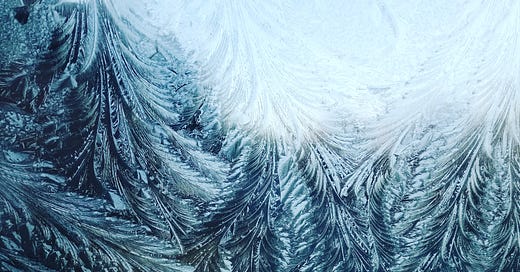We tell ourselves so many stories about beginnings. How we decided to have this baby. How we made this family. We don’t talk so much about what happens when that story falls apart.
Wait.
Don’t be too sad.
The winter I decided to have a baby it rained and rained. Water pooled everywhere. In the plant nursery where I work, it was so wet that puddles of water seeped under the doors. The concrete path was invisible under lakes of muddy water threatening to spill into the over-full compost heap beside it. Rain kept falling into grey water.
The land hereabouts floods easily. Sometimes the river bursts its banks and overtakes the bridge; often the water spills over into the fields. On the way to the fertility clinic, churning lakes of water shushed against the tyres, foaming, formless.
I thought about the centuries of women who have tried to have babies. In medieval times, doctors told women they were naturally watery, full of fluids that threatened to spill out in the form of tears or gushing emotions. Those female liquids, that blood, those tears, were signs of a body unable to keep within its proper boundaries. Medieval medics would have grasped the concept of the liquid hormones in IVF syringes with no trouble: fluids for conception, beading at the tip of a needle. In their understanding, a fertile womb must be moist, but not too moist: ready to receive the imprint of the masculine emission that functions like a stamp, giving form to what is fluid and formless. I thought about those centuries of women, trying to will fluid into form, as we drove.
IVF is a constant waiting: a slow, slow splitting of two cells into four cells, that takes a day and a night. At this time of year it is a short, short day and a long, long night. I remember my older daughter in utero, wakeful in the night time, moving and turning in the dark. Cells splitting, doubling. A cracking open, like the skin of a tulip bulb. A knitting together. The process is a perfect antonym, a cleaving apart of cells that is also a cleaving together, my DNA welding itself to the DNA of someone completely separate. You want those cells to reach day 5; you want them to be good enough - to be formed enough, structured enough - to freeze, so they can be tested to see that all that doubling and dividing went as it should. Waiting, waiting.
The day the clinic rang to say we had embryos to freeze, the temperature plummeted. Ice crystals formed on all the paths; the fountain in the courtyard feathered into strange, futuristic stalactites, like something out of Narnia. Driven in by the cold, a kestrel flew in through the narrow passageway, landed on the ground, and paused for a moment, before throwing itself up into the air again, like a visitor from another world. I am 40. Four embryos felt like a miracle; a thing as unlikely as a bird. I breathed. Water took on structure. Wings beat.
So I read about ice. I read how Robert Hooke studied snowflakes under his seventeenth-century microscope. Not knowing how they form - fractal branch by branch around some tiny mote of dust or ice - he imagined they began as lattices of perfect hexagons, hanging in the upper air. Hooke thought that, as the hexagons fell, winds whirled them, point against point. By the time they reached the earth, their own sharpness had punched out shards and splinters, like a child snipping triangles from folded paper. A perfect, imagined beginning, thrown into chaos.
Stop. Hold your breath, or the frost will melt.
Then the clinic called. These embryos are missing chromosomes. A mistake, in all that splitting and doubling. A cut that went too far; a scrap of paper clinging to the scissors. A beginning that never was.
Don’t be too sad.





Hauntingly beautiful. So sorry Lucy.
Gosh this is beautiful. Heartbreaking. But beautiful.